
2/10/7 - 2/19/7
christopher funderburg
In October 2006, Funderburg and Cribbs set out to watch at least 200 movies over the course of the next 200 days. They both watched a different slate of films and wrote about every single one; from epic high art masterpieces such as Fassbinder's 15 & 1/2 hour Berlin Alexanderplatz to goofy teen comedies like Savage Steve Holland's worthy One Crazy Summer to idiotic dreck like Open Water 2. In sections spanning 10 days at a time, The Pink Smoke is reprinting their writings about the grueling experiment in cinematic endurance.
2.10. Reality Bites.
(an almost pathetically well-worn vhs copy) at Laurie Isabelle's insistence, while Allen Cordell fumed.
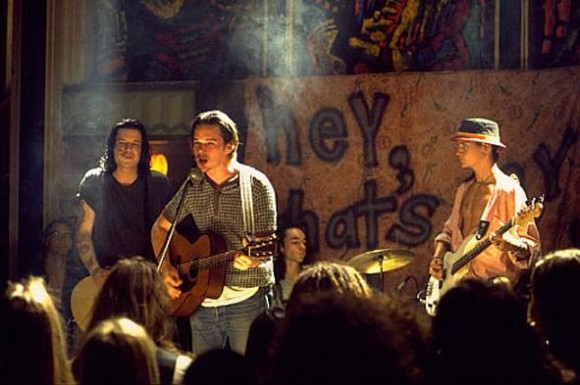
And I must admit, I instigated the fuming. Every fucking girl of our generation was so in love with Ethan Hawke in this movie and why? He is a grade-A pretentious piece of shit in a lame band. His band is named "Hey, That's my Bike!" That's the name of his goddamned band! Why does he get a free pass for acting like a complete tool at every opportunity? Oh, his dad is dying. He just feels too deeply and is too profound to be bothered with being a good person. Meanwhile, Ben Stiller is the villain? He only treats Winona Ryder with respect and affection, gets her a gigantic opportunity to get her documentary aired on television, and all the while provides her with stability and support. But, oh, did I mention that Ethan Hawke reads Heidegger? Everyone knows the only student of philosophy in the history of cinema worth a damn is James Dalton!
Whatever, I'll always play Ben Stiller to the world's Ethan Hawkes and that's really the problem, isn't it? For the record, though, those guys dont read Heidegger in real life. They live in Williamsburg, are really into graphic design and talk about"punk rock" as though that's not embarrassing and ridiculous. At any rate, there's a level on which this film really works I can't imagine having such a strong reaction to it if it weren't so adept at pushing all the right buttons. It's a perfect example of the manipulative power of standard narrative style: you know exactly who you're supposed to root for even when it doesn't make an ounce of sense. Everything is set up neat and tidy and you don't bat an eye when you see the final shot of Winona and Ethan moving into their new apartment. You don't think, "How long am I supposed to believe that's going to last?" Anyway, Laurie was pretty pissed at how much Allen and I were slagging the film. I felt bad it's clearly a guilty pleasure for her and I wouldn't want people sitting around talking shit on Before Sunrise or something while I tried to watch it.*
*As a side note, I saw Laurie like three weeks later and she mentioned that she stills needs to watch Reality Bites and I said, "what do you mean we just watched it?" She then explained that Allen and I had so totally ruined the experience for her that she felt like she hadn't even seen it. Now, I really feel like an asshole. Oh, well.
The Blossoming of Maximo Oliveros.
(dvd) my apartment.
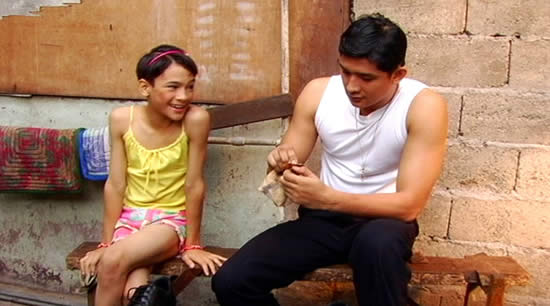
It's that time of the year when we program our annual GLBT series at the JBFC, so I end up seeing a couple movies here and there to help our my colleagues Kathy Bonomi and Lois Dino with the programming. Overall, selecting films for this series tends to be a bit of a chore; because of their specific niche status as "gay" films, the possible selections generally fall into either one of two categories: art films with gay themes/characters that weren't good enough to stand on their own as art films (unlike say, Tropical Malady which escapes the "gay niche" ghetto by being considered a legitimate artwork of interest to non-GLBT audiences) or gay takes on bland Hollywood genres (e.g. standard romantic comedies featuring lesbians, horror films that take place on Fire Island, Scary Movie-style spoofs of "gay" movies, etc.). In other words, if the films were particularly of interest, they probably wouldn't be popping up in a GLBT screener pile.
To me the most interesting films usually end of being "hidden history" documentaries that chronicle forgotten and/or obscured chapters of gay life in America for instance, last year we showed the bluntly titled Gay Sex in the 70's which wasn't anything more than a PBS-style reportage on the eponymous subject; but it featured a pretty mind-boggling examination of bath houses, sex trucks, lunch-time blowjobs, cocaine, disco and sweaty male abs. I'm not sure how much these docs matter to the intended GLBT audience - presumably, some of them were there and don't need the history lesson that this middle-class straight white dude from the South found so eye-opening. But on the other hand, the series is a good excuse to show other heart-breaking docs like Rob Epstein's brilliant The Times of Harvey Milk; which I can't imagine would fail to move even the most knowledge, politically active queer.
Maximo Oliveros isn't a documentary, though it falls into the category of "failed art film." Fortunately, though, it doesn't fail badly and all that really ends up holding it back from legitimacy is its painfully obvious budget constraints. It's a sweet-natured story in the Italian Neo-Realist mold of an adolescent homosexual coming of age in a dirt-poor shantytown in the Philippines. The "you are there" style of capturing the filthy canals, the crowded conditions, the sweltering heat and the omnipresent detritus of the setting works hugely to the film's advantage and is almost enough to overcome the awkward narrative and amateurish acting. I'm not sure if the leads are non-professionals or not, but their performances feature the frequent lapses in concentration and moments of unstudied, irreproducible authenticity that characterize non-professional performances. Also, the film's loose, "play it as it lays" approach to improvisation and dramatics has the "found moments" appeal that I usually associate with coaxing performances from non-actors.
The main story follows Maximo's budding (you might say "blossoming") feelings for a good-hearted police officer and the film's biggest problem is its gradual slide into melodrama the more plot-oriented it becomes, the worse off it is. That said, the unpolished and fundamentally good-natured take on destitute life in the Philippines has a charm that makes you want to cut it plenty of slack I'm genuinely curious what the director will do if he ever gets a chance to make a film with a budget of more than $100.
2.11. Deranged.
(vhs) upstairs with Allen and Laurie.
Normally, each week we get several totally unsolicited films sent to us here at the JBFC. By this, I don't mean the stuff that distributors send us that we haven't asked for; I mean movies that individual filmmakers send us out of the blue to see if there's anything we can do with them. Most of the time, I glance at them to see if there's any particular series into which they'll fit (political documentaries for "Global Watch" in November, GLBT films for "Out at the Movies" in May, kids' films for the cleverly named "Movies for Kids and their Families," etc.) and, if they don't seem like a fit for any particular series, I put them in a stack and kind of forget about them we're not a festival and I just have too much to do to watch three or four movies a week on top of my normal work-load. If a filmmaker is persistent, I'll usually give the film a look.
Deranged was once such unsolicited submission. The filmmaker, Shirley Thompson, followed up a couple times, but I couldn't remember getting the tape (because I had kind of forgotten about it). Anyway, I tracked down the tape, but I had no idea what it was about I knew if it was on the back-burner stack, though, that it probably didn't fit the profile for any of our regular series. What the hell was it about? I quickly looked it up on imdb. Not listed. So, I googled the director/title and found a listing for it. Here is the description offered up by the producers of the film, corrected for neither grammar nor spelling:
"Two brother who were abused as kids one retarded the other one inranged. They killed the mother and were put into foster care. They escaped and lived in abandon buildings and finding shelter any way or any where they could. Though their journey they killed about 20 people all different ways. Anyone who got in their way was dead,and they enjoyed killing."
But the best part was its tagline:
"DERANGED is a different kind of horror film. It shows everything when the killings take place you see it all."
Well, why didn't you say so? I'd sure like to be able to see it all when the killings take place- I wish I had read that the day it came in. So, after reading that delicious description, I immediately sat down to view this brain-melting cinema oddity. First of all, I should be clear: there's a level on which this film is unwatchable. Most people would call that level the "primary level." It is shot on vhs, loaded with z-grade special effects, over-flows with porn-level acting, and features a jaw-droppingly erratic plot that goes on for a good hour after you think the film is going to end. It's really, really, really terrible. It's nothing. It's on that level.
The main character is Jersey guido-style, pony-tailed body-builder type with bad teeth and even worse acting ability. He is the titular "deranged" killer - but I more like to think of him as the "inranged" killer of the online synopsis. His brother figures prominently in that above synopsis, but he really only shows up every now and then delivering a Mark Torgel-esque tour-de-force performance as a simpering, moronic pervert. The killers are inexplicably positioned as anti-heroic protagonists, but that seems mainly to be a result of the director's total lack of self-awareness (as opposed to some Devil's Rejects-ish maneuver to tweak the audience). The director's earnest approach to cheesy severed heads and dry police station exposition is matched note for note by the muscular star's sedulous portrayal of a self-pitying nutjob. The bugged-eyed passion on display in the scenes in which he shoots up the remarkable serum that keeps his character alive is nothing short of wondrous. I'd believe this pony-tailed greaseball to be in real life exactly like his repulsive character, if only terrible acting didn't ravage every ounce of credibility in his performance. This is a film that seems like it was made by someone raised on 80's slasher films, molested repeatedly and then given a camcorder. I highly recommend you see it.
2.12. Inside Out.
(vhs) on my tv.
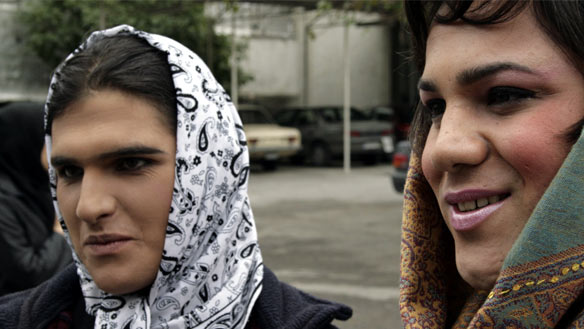 This is one of the interesting "secret history" GLBT documentaries to which I was referring in Maximo Oliveros write-up: a frequently stunning account of transsexuals living in Iran. I certainly didn't know anything about the culture of such things in Iran and I had (it turns out mistakenly) assumed that the religious community in that country would react to transsexuals with the same violence that it directed towards women and homosexuals. Interestingly, that's not the case at all and the culture's surprising attitudes about transsexuality intriguingly bring out a lot of the unconscious politics below the surface of sex and religion: nothing makes the irrational biases of your own cultural more readily apparent than witnessing the virtually nonsensical permutations of another society's mores. Can you imagine Southern Baptists actively supporting gender reassessment surgery? Well, why not? I'm sure Muslim clerics can't fathom why Western Christians support the eating of shell-fish. At any rate, the three people at the center of the film prove to be less fascinating subjects than the larger issues swirling around their sex-changes; they're never quite as engaging or articulate as you would hope they would, but the film still has enough political/sexual/religious charge to sustain its reasonable hour-long running time.
This is one of the interesting "secret history" GLBT documentaries to which I was referring in Maximo Oliveros write-up: a frequently stunning account of transsexuals living in Iran. I certainly didn't know anything about the culture of such things in Iran and I had (it turns out mistakenly) assumed that the religious community in that country would react to transsexuals with the same violence that it directed towards women and homosexuals. Interestingly, that's not the case at all and the culture's surprising attitudes about transsexuality intriguingly bring out a lot of the unconscious politics below the surface of sex and religion: nothing makes the irrational biases of your own cultural more readily apparent than witnessing the virtually nonsensical permutations of another society's mores. Can you imagine Southern Baptists actively supporting gender reassessment surgery? Well, why not? I'm sure Muslim clerics can't fathom why Western Christians support the eating of shell-fish. At any rate, the three people at the center of the film prove to be less fascinating subjects than the larger issues swirling around their sex-changes; they're never quite as engaging or articulate as you would hope they would, but the film still has enough political/sexual/religious charge to sustain its reasonable hour-long running time.
2.13. Shaun of the Dead.
(ipod) on Eric Pfriender's fancy ipod while he edited an extremely crappy documentary about the devil.
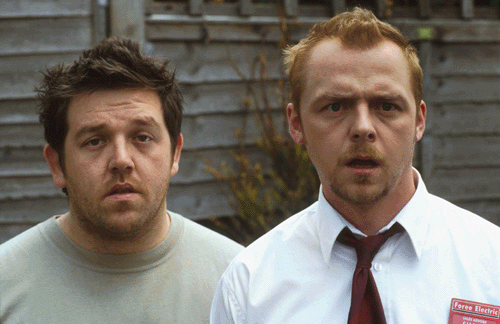 I had only seen it once before this screening, but I actually don't remember the first time I saw Shaun of the Dead. It's a story that, for whatever reason, I've had related back to me a couple times: I had really low expectations, I saw it with Charlotte Glynn on a whim, it was awesome, and I tried to convince everyone I know to see it. I don't remember the theater, I don't remember seeing it, I don't remember talking about it all that much, but I do remember being pleasantly surprised at how good it was. So, I was fairly excited to see it again it was honestly kind of puzzling that I hadn't. It was one of those solid "A-" movies in my mind: charming, not particularly ambitious, perfectly executed. I thought of it as a movie that I really enjoyed and was looking forward to incorporating it into my regular rotation. That just never happened for whatever reason.
I had only seen it once before this screening, but I actually don't remember the first time I saw Shaun of the Dead. It's a story that, for whatever reason, I've had related back to me a couple times: I had really low expectations, I saw it with Charlotte Glynn on a whim, it was awesome, and I tried to convince everyone I know to see it. I don't remember the theater, I don't remember seeing it, I don't remember talking about it all that much, but I do remember being pleasantly surprised at how good it was. So, I was fairly excited to see it again it was honestly kind of puzzling that I hadn't. It was one of those solid "A-" movies in my mind: charming, not particularly ambitious, perfectly executed. I thought of it as a movie that I really enjoyed and was looking forward to incorporating it into my regular rotation. That just never happened for whatever reason.
So, I sat there with some headphones on and watched the film as the venerable Eric Pfriender (who is also writing an interesting 15 movies in 20 days blog, you should check it out) edited this absolutely retarded documentary about the devil for the WE network. The hard-hitting expose on the Dark Lord even promised to show the audience a bona fide picture of Satan himself at the end of its hour-long (minus commercials) running time. I won't spoil it for you, except to say that the devil apparently has David Berkowitz's neighbor's dog's nose and Charles Manson's eyebrows. And the gap teeth of a slurry French Satanist. But perhaps I've said too much.
But back to SotD: I don't want to say I didn't like it this time, but I definitely cooled on it a little. There's not a whole lot to it and it coasts on the estimable charm of its two likable stars. There aren't many jokes really (there's much more good-natured camaraderie and dicking around than comedy per se) and not many of the set-pieces are really so dynamite the second time through (a pool cue beat-down to "Dont Stop Me Now" is exactly the kind of thing that is just clever enough to work exactly once. And I love Queen). The film is really more of a reliable "B+," an affable time-waster with lots of quotable lines and a genuinely effective zombie apocalypse story-line. You can do a hell of a lot worse.
2.14.
One of the best days of my life. True story.
2.15. Viridiana.
(35mm) Jacob Burns Film Center.
Always nice to see a 35mm print of a great film. I had previously only seen it on dvd (and, initially, on vhs) and it's always strange to go experience a film again for the first time: seeing a film on a 35mm print is like having it unlocked from some kind of prison. I don't want to seem hard on digital formats because I really like dvds and think that every year digital projection and photography improve I'm certainly not going to cry that the only way I'll get to see something sort of obscure and rarely screened like, say, Tenebrae or Q, The Winged Serpent is on dvd. To put it another way: seeing something on vhs, I felt like I was experiencing 80% of the movie, tops. It was fine if you wanted to get a short-hand feel for the film or didn't care about the movie particularly or didn't have any other choice, but movies that I've only seen on vhs I actually won't go so far as to say I've actually seen them - I've just experienced some Cliff Notes-level version.
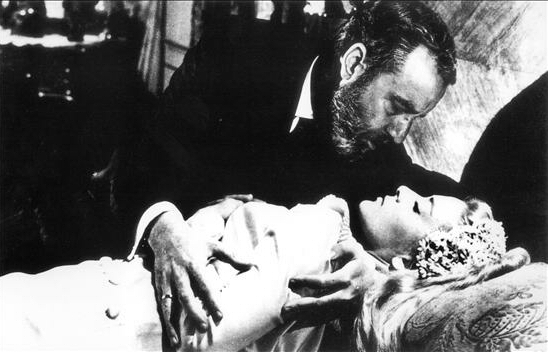
With dvd, I feel like Im getting 90 or 95% of the film; with projected dvd on a big screen with a good sound system, even more. But don't let anyone tell you that last little bit doesn't matter. At the end of the day, I feel like I actually, finally ingested Viridiana, despite having seen it a half-dozen times previously. I'm not one to parse technical details and pontificate on "muddy blacks" or "image resolution" or "grey scales" all I can speak to is the difference in feeling, the indescribable textures that will always be different between light shining through emulsified silver versus electronic signals giving orders to a processor. In a film like Viridiana, Bunel's trademark sensuality is the element most compromised in that missing 5% (or so) and seeing a print of this film with an audience in a darkened theater became a genuinely perverted experience. When Fernando Rey pulls open semi-conscious Sylvia Pinals shirt, there was gasp, a jolt of electricity that ran through the theater from the palpable sense of her body and sex. As much as I've always loved that scene's creepy mix of rape and holiness, I never felt that jolt before this screening. Everything from the foot fetish shots to justifiably notorious climactic scene had an urgency, texture, and physicality that simply can't be felt when watching a dvd at home. I'm glad I went to this.
2.16. The Saviour.
(BetaSP) Jacob Burns Film Center.
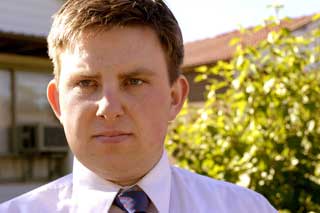
This and the next four films were the five nominees for the Best Live Action Short Academy Award. Two of them were absolutely god-awful and made the mysterious process of generating such nominations seem even more confounding. I was surprised to see that only one of the nominees was made by an American filmmaker and that none were filmed within the US. The Australian The Saviour was my second favorite entry, even if it was ultimately a mile behind the best film: Binta and the Great Idea. The Saviour is the story of a young (Mormon? Jehoavh's Witness?) church Elder who each afternoon takes a break from door-to-door proselytizing to nail a middle-aged married woman. When she ends their relationship, he has a breakdown of sorts, compromises his standing in the church and ends up confronting the woman and her husband. The chubby-faced male lead brings a nice balance of humor and pain to a character that is essentially pathetic and deluded. That balance is especially delicate as the film on the whole constantly skirts parody while never falling over the edge into cheap laughs. The film's main virtue is that it never overplays its hand to become yet another condescending critique of religious hypocrisy sure, the fresh-faced gaggle of Elders is played for laughs, but the filmmaker also seems to have a genuine affection for his characters that subverts the obvious satirical elements. The final scene of awkward confrontation is actually extremely well written and performed and I'm interested to see what this filmmaker does next.
Helmer and Son.
(BetaSP) Jacob Burns Film Center.
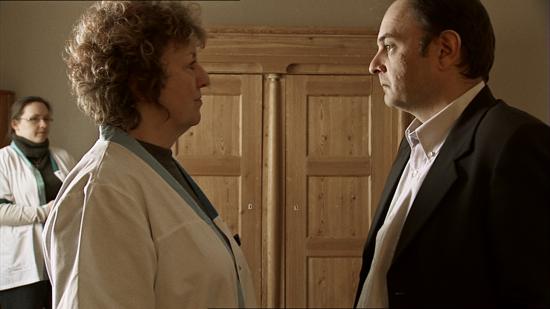
This thing is really embarrassingly bad. A businessman's eccentric, elderly father locks himself inside a wardrobe and refuses to come out until the businessman learns some important life lessons. It's all very wacky and heart-warming. I'm not sure if I'm supposed to be impressed by the fact that everyone involved is Scandinavian or if the Academy just can't get enough of yucky sentimentality masquerading as serious art, but I genuinely cannot imagine why this film would be singled out in any capacity for any award. It primarily reminded me of those European commercials that occasionally pop on youtube with naked old women and swearing: it feels slick and soulless, like it's hawking a product - the product in this case being "important life lessons." It's the Danish Little Miss Sunshine, an ipecac-grade load of maudlin bullshit and zanily dysfunctional characters.
Eramos Pocos (One Too Many).
(BetaSP) Jacob Burns Film Center.
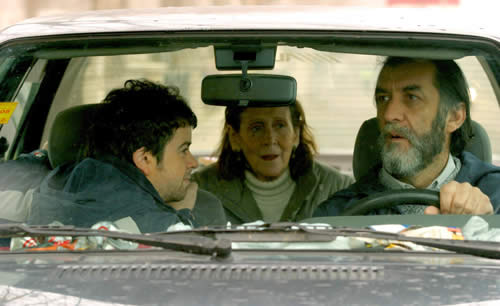
There's a level on which this film suffers most from being a feature length idea stuck in a short film format: after a slovenly father and son are deserted by their wife/mother, they decide to change their life to win her back. Without much deliberation, they decide the best method will be to bring home the elderly mother-in-law from the old folks home to which she was consigned at the father's behest. And if she happens to want to cook and clean, well, that's just an added bonus. The father and son are an enjoyable pair of likeably selfish losers you want the movie to give their rambling, slobby relationship time to breathe and meander at its own pace. As it stands, the movie rushes the plot along without spending enough time elaborating on the dingy details of their day to day existence. You don't get a chance to develop much of an emotional relationship to them, even a negative one when their scheme to redeem themselves becomes blatantly exploitative. The introduction of the mother-in-law adds a nice layer: she's so thrilled to be out of the dank, depressing home that she's willing to turn a blind eye to their crude, self-serving inclinations. The ending doesn't have quite the power or meaning you want it to, but that's mainly the effect of the narrative being compressed into twenty or so minutes: this is one of those short films that you see and hope the filmmaker has plans to expand it into a feature.
Binta and the Great Idea.
(BetaSP) Jacob Burns Film Center.

This film defeated me and I tip my hat to it: from the opening scenes I had it pegged as a heart-warming ethnic comedy. There's an adorable little girl in a small African village. Her dad tells her that birds are actually smart and humans could learn a lot from them. She goes to school, but her conservative uncle makes her teenage cousin stay home and do "women's work." There's a bit of amusing culture clash comedy surrounding a Swiss watch that beeps at noon. Yeah, I had this movie pegged. But, I was wrong. I don't want to spoil anything because you should really see this film if you get a chance it unfolds totally unexpectedly, doubles back on itself, and ends with a "fuck you" to know-it-alls like me. And what makes it a home run is that it never descends into cynicism or compromises its sunny disposition to deliver its razor-sharp critique: it's emotionally astute, philosophically complicated, warm, and witty. Maybe even knowing that much will dispel its potency, but it definitely set me up and I took the fall.
West Bank Story.
(BetaSP) Jacob Burns Film Center.
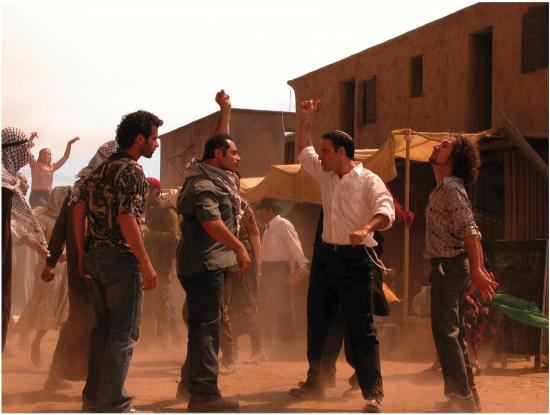
A truly irritating parody of West Side Story with the warring Jets and Sharks replaced with get this! Israelis and Palestinians. The whole thing is done up in a barn-door broad "comedic" style that's far too hammy for any of its Jewish characters to ingest. The "laff riot!" style pulls double-duty, defusing any potential offensiveness (and complexity) while simultaneously wringing out every obvious joke to be had from an idiotically one-note premise. The filmmakers clearly had a boatload of money for fancy sets, professional choreography, a big cast, and location filming, which makes the entire steaming pile all the more repulsive; I'm sure the filmmaker will have a very lucrative career directing sitcoms and network sketch comedies that are cancelled after six episodes. Don't worry, it has an important underlying message about how Israelis and Palestinians should get along and open falafel shops together. It makes perfect sense if you think about it.
2.17. A Snake of June.
(dvd) my apartment.
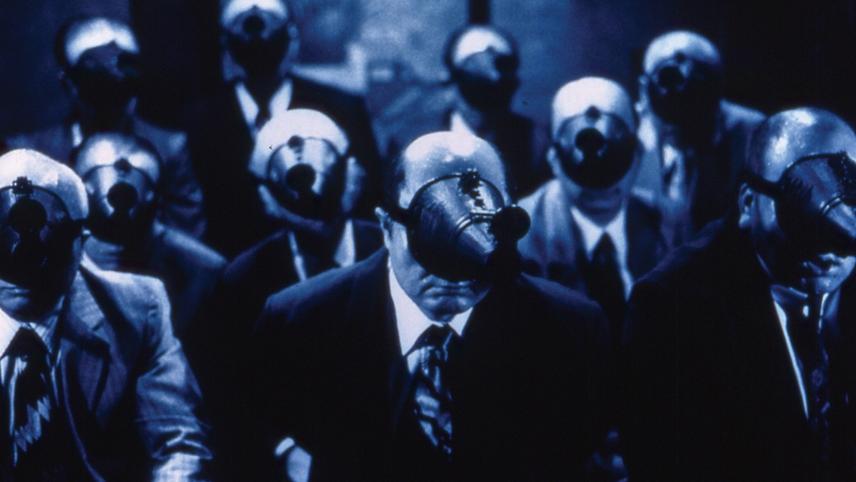 Shinya Tsukamoto is another one of those cult filmmakers that looms large in my imagination and, despite the following for his film Tetsuo, I have a tendency to forget that he's virtually unknown to most folks. A Snake in June is probably my favorite of his films it achieves an extremely delicate balance of authentic pathos and vertiginously insane body horror. It's divided up into three unequal parts, the start of each part denoted by a title-card with a single symbol on it: the first two title-cards feature the traditional "female" and "male" symbols, respectively. The third title-card
the third title-card combines the two symbols into something that resembles a horned demon. The first and longest part ("female") follows a repressed Japanese house-wife who works for a suicide crisis hotline. One of her callers black-mails her into a series of sexually humiliating acts. The second part ("male") follows the woman's schlubby, bathroom-cleanliness obsessed husband as he uncovers her bizarre relationship with the caller. The final part follows the caller himself.
Shinya Tsukamoto is another one of those cult filmmakers that looms large in my imagination and, despite the following for his film Tetsuo, I have a tendency to forget that he's virtually unknown to most folks. A Snake in June is probably my favorite of his films it achieves an extremely delicate balance of authentic pathos and vertiginously insane body horror. It's divided up into three unequal parts, the start of each part denoted by a title-card with a single symbol on it: the first two title-cards feature the traditional "female" and "male" symbols, respectively. The third title-card
the third title-card combines the two symbols into something that resembles a horned demon. The first and longest part ("female") follows a repressed Japanese house-wife who works for a suicide crisis hotline. One of her callers black-mails her into a series of sexually humiliating acts. The second part ("male") follows the woman's schlubby, bathroom-cleanliness obsessed husband as he uncovers her bizarre relationship with the caller. The final part follows the caller himself.
Aside from the singular balance of horror, surrealism, b-movie perversion, genuine emotion, and razor-sharp intelligence, A Snake in June is remarkable for its unique visual texture: the film's aesthetic normally gets labeled as "black and white," but "black and blue" would be more accurate, as the color ranges from sharp pitch blacks to rich, gloomy azures. The film is sopping wet and it rains in nearly every scene the soaked atmosphere adds a layer of sensuality to the sexual elements and a sense of claustrophobia to the depiction of marital discord (the light tapping of rain on windows and ceilings emphasizes the cramped structure into which the husband and wife are sandwiched), almost every frame is saturated with wringing-wet moisture. Combined with the simple and gorgeous photography, the feeling of this film and the world it generates are so extraordinary that I really have nothing to which to compare it. I should also mention that Tsukamoto himself plays the caller and his brand of creepy intensity (you might remember him as the tiny criminal with surprising muscles in Ichi the Killer) this time also has an element of sensitivity that drives the film forward: his character is a sharply drawn mess of pain, regret, anger, self-pity, focus and hope. Also, most importantly, his character is a well, even if I knew how to describe it, I wouldn't want to spoil it.
2.18. Along Came Polly.
(dvd) with Megan Bennett in her apartment.
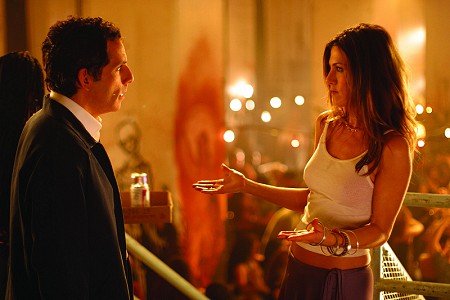 I will admit that I enjoyed this film much more than I thought I would. I've always hated "Philip Seymour Hoffman, Serious Actor" but this film won me over on "Philip Seymour Hoffman, Shameless Comedic Foil." Sure, it's easy to spout goofy one-liners while dicking around during a pick-up basketball game and to flounce your disgusting gut to comic effect, but the self-serious method intensity that's so off-putting in something like Love Liza adds a layer of commitment to these stupid, obvious gags that's very winning. He's a washed-up former teen star chugging along pathetically through life, giving his best friend Ben Stiller bad advice at every turn. Ben Stiller offers nothing aside from his usual tightly wound neurotic shtick, Alec Baldwin is amusing in a broadly conceived performance, and Jennifer Aniston is somehow overmatched even in this ignominious setting.
I will admit that I enjoyed this film much more than I thought I would. I've always hated "Philip Seymour Hoffman, Serious Actor" but this film won me over on "Philip Seymour Hoffman, Shameless Comedic Foil." Sure, it's easy to spout goofy one-liners while dicking around during a pick-up basketball game and to flounce your disgusting gut to comic effect, but the self-serious method intensity that's so off-putting in something like Love Liza adds a layer of commitment to these stupid, obvious gags that's very winning. He's a washed-up former teen star chugging along pathetically through life, giving his best friend Ben Stiller bad advice at every turn. Ben Stiller offers nothing aside from his usual tightly wound neurotic shtick, Alec Baldwin is amusing in a broadly conceived performance, and Jennifer Aniston is somehow overmatched even in this ignominious setting.
Aniston is theoretically playing against type as a tramp-stamped wild woman who totes about lower Manhattan eating exotic food and dancing all night in underground salsa clubs. It's pretty remarkable that she's unable to pull off even this level of utterly square "hipness" the character is like what your aunt from Houston thinks is dangerous and "out there." Rest assured, Aniston isn't even that far "out there" and her manicured blandness undercuts the romantic foibles at the heart of the story am I really supposed to believe Jennifer Aniston (Jennifer Aniston!) has something against throw pillows? Bull. shit. Nevertheless, Baldwin, Hoffman, and a leathery Bryan Brown provide more than enough distraction to make it work. A Hank Azaria cameo bookends the film, but I can't decide if his performance is funny or irritating. I'd like to cut him some slack (it's got to hurt being dumped by Helen Hunt), but his banana-hammocked* scuba instructor is exactly the kind of one-note comedic conceit you'd expect from a film like this. His confession of heart-break does just enough to redeem the character and make you like him while not changing the fact that on the whole his character isn't funny or interesting. That goes for the movie on the whole: it does just enough right that it feels unfair to dislike it.
* Did you know that the word hammock was given to us by the Arawak Indians, the first native people Columbus encountered on his voyage to our great continent? Incidentally, the Arawak people were so thoroughly annihilated by the encroaching Europeans that this word is virtually all that remains of their culture. I say that's no way to have treated the geniuses who came up with the history's greatest achievement. Im willing to go out on a limb here and say it: there is no excuse for genocide.
2.19. The Phantom Carriage.
(35mm) Jacob Burns Film Center with live piano accompaniment by Ben Model.
I spent the dawning of the New Year sitting alone on a stoop, dead sober, vaguely aware from the muffled sounds of cheering coming from a nearby bar that the clocks had struck midnight. It's hard to say how I ended up there, on an empty street in the middle of Manhattan, but I had the distinct impression that the life I was living was not my own. I remember staring absent-mindedly into an apartment in the brownstone across the way and thinking that there was no where I wanted to be that I could've been. Weeks later, I went with John Cribbs to this screening at the Burns; I was interested in seeing the film that had been so formative in Ingmar Bergman's youth that he professed to have seen it dozens of times before casting its director/star Victor Sjostrom as the lead in Wild Strawberries.
The story of an unrepentant bastard who dies at the stroke of the New Year's midnight and is in turn forced to helm death's carriage for a year, Phantom Carriage's haunting double-exposures and grim, pervasive melancholy build to a devastating effect. The narrative overlaps into flashbacks and folktales like the layered images of the ghastly carriage overlap with the real world of its sorry passengers, interconnecting the twisting stories of ruined marriages, drunken outbursts, and suicide. There's so little reason for this bastard to want to be a good person, what the hell does he owe his own life? Leaving the theater on a freezing cold night, I thought of my own New Year's Eve and the final prayer delivered by the human failure at the heart of the story: "Lord, let me soul come to maturity before it is reaped."
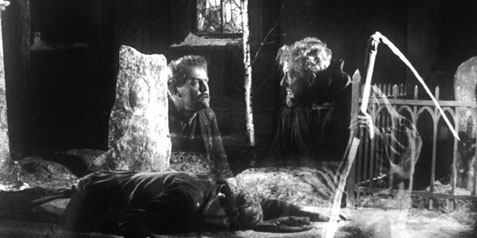
home about contact us featured writings years in review film productions
All rights reserved The Pink Smoke © 2009